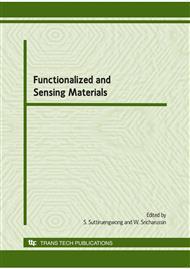p.381
p.385
p.389
p.393
p.397
p.401
p.405
p.409
p.413
Porous Alumina through Protein Foaming-Consolidation Method: Effect of Stirring Time and Drying Temperature on the Physical Properties
Abstract:
The porous alumina ceramics were fabricated through protein foaming-consolidation method using egg yolk as pore creating agent. The influence of stirring time and drying temperature on the physical properties of the porous bodies was investigated. The porosity of the 3 h stirring time’s sample was 42% and it increased to 71% at 24 h stirring time. As the drying temperature increased, the pores became interconnected with less dense and thinner pore and were found in the range of 100-650 µm. The density of 180°C drying temperature’s sample was 1.5 g/cm3 and it increased to1.9 g.cm-3 when dried at 100°C. An alumina-to-yolk ratio of 1.4 in weight was found to be optimum composition to give porous bodies with higher compressive strength. The compressive strength of the porous bodies increased from 3.7 MPa at 61.1% porosity to 7.7 MPa at 42.5% porosity, showing that the compressive strength is strongly dependent on porosity.
Info:
Periodical:
Pages:
397-400
Citation:
Online since:
January 2010
Authors:
Keywords:
Price:
Сopyright:
© 2010 Trans Tech Publications Ltd. All Rights Reserved
Share:
Citation:


